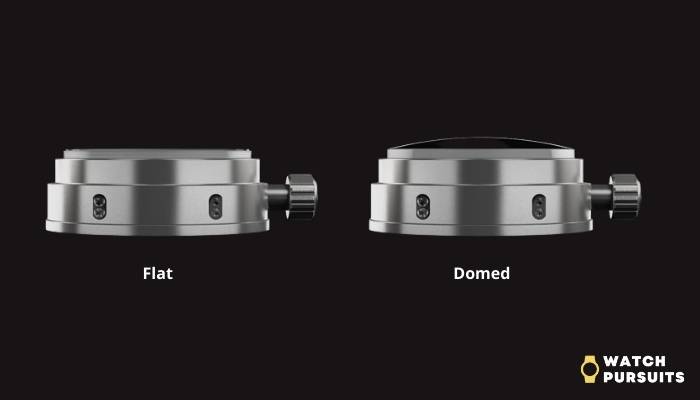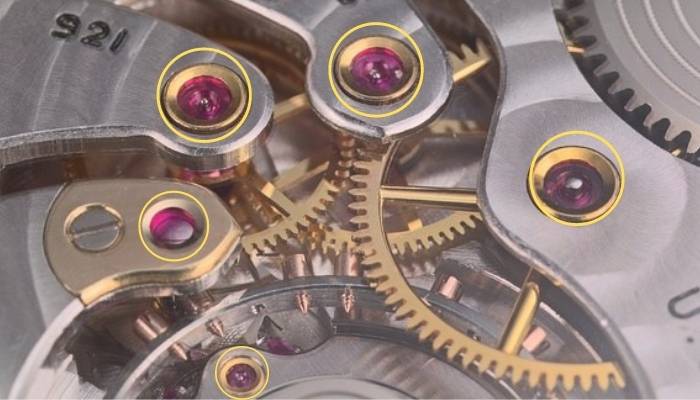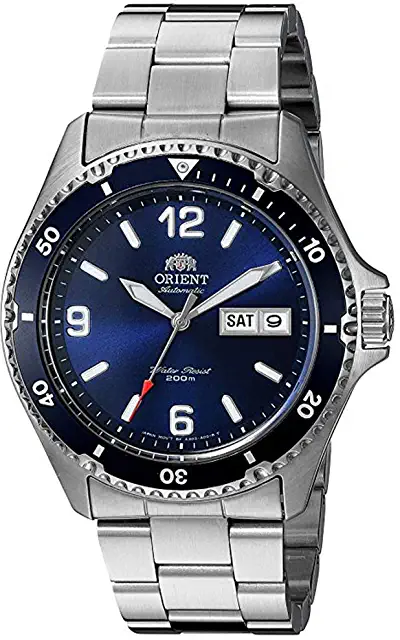When browsing for timepieces, you sometimes end up seeing or hearing jargon terms that are hard to understand.
You might have lots of questions too. What is a Bezel? Caseback? Crown? What is the difference between automatic and quartz?
These are fundamental questions and can be confusing to many. It might intimidate new new buyers too.
This is why we created this post. The goal is to provide a quick overview of the parts of a watch, with a brief explanation. We keep the fluff out, so you can get directly to the point.
If you are keen to explore a specific part further, we have links to point you to them.
But this article should be enough to function as a ‘crash course’ to get you confident enough to shop for your timepiece.

Case
A watch case is the ‘house’ of the timepiece.
A good watch case should protect everything inside and withstand wear, tear, and abuse from the outside.
You might see some variables when it comes to timepiece cases:
Materials
Cases are usually stainless steel. Lower priced models tend to use resin or plastic, while premium and luxury ones might use titanium or precious metals.
Finish
Watch cases could have a brushed, smooth, high-polished finish. More premium timepieces tend to combine these finishes.

Shape
Round is the most popular, with other rectangular, tank, or tonneau shapes.

Caseback
The caseback is the covering placed at the back of the case, the surface in contact with your skin when you wear your timepiece.
A strong caseback creates a tight seal with the watch case to avoid excess moisture or dust from entering the inside of the timepiece.
There are several variables to look into when it comes to caseback:
Material
Most timepieces use a stainless steel case back. Many automatic timepieces use sapphire crystal to create a see-through or ‘exhibition’ caseback.
Screw
Screws help caseback to bind with the case. There are several ways to screw the caseback with the case. Most timepieces use the screw-down caseback.
In a screw-down caseback, the edge of the caseback has grooves on it, which are then slowly turned and screwed together with the watch case.
Lower priced models might use traditional screws, while some also use a snap-off case back.
Lug
Watch lugs are the ‘horns’ or extensions from the watch case.
Lugs allow the watch case to connect to watch straps.
They usually appear at the top and bottom of the timepieces and use similar materials with the case.
Some variations to think about when looking into watch lugs:
Flat vs. Curved
Flat lugs simply extend out from the case. Curved lugs extend out from the case and curve downwards.
Watches with curved lugs are more comfortable to wear, as they hug the wrists better.

Lug-To-Lug Distance
Lug-to-lug distance refers to the distance between:
– Top-end of the top lug, to the
– Bottom end of the bottom lug.
This measurement helps determine case size, which can be a guide to see if the timepieces is suitable for the person’s wrist size.
There is a proper guideline on this, but a smaller case size generally fits smaller wrists, while a larger case size fits larger wrists.

Dial
In its barest form, a watch dial is the ‘face’ of the timepiece.
Many watchmakers also use the dial to enhance the aesthetics of the watch. It is one of the most distinctive places for watchmakers to stand out.
Some variables for watch dial:
Material
Metal plates are standard. Premium timepieces might use metal plates with ceramic coating. Some also use unique materials such as mother of pearl or granites for dials.
Finish
Watch dials usually have a smooth or sunburst finish.
Premium and luxury timepieces tend to employ more intricate finishings such as textured, linen, teaked, Tapisserie, or skeleton.
Some watchmaker also made special edition dials, such as Rolex with the jubilee dial.
Skeleton dials are gaining in popularity. It is a form of a transparent dial, allowing the wearer to see the intricate parts of the timepieces.

Markers
On top of the watch dials, watchmakers will add markers to help you to tell time.
Watch markers appears on the dial by hour. That means a mark every hour.
Some watches added minute markers too.
Some of the variations for dial markers:
Type
Markers could be in Arabic numbers (1-12), Roman numerals (I – XII), or indices. Indices could be in various shapes such as square, baton, or round.
Some timepieces use other markers, such as in a foreign language, but these are not common.

Application
Printed markers are common on watches.
The markers are physically applied to the dial in more premium timepieces, resulting in a 3D appearance.
Lumination
Some watch markers have lumination, basically a ‘glow in the dark’ feature that allows you to tell the time on your timepieces even when it’s dark.
Lumes are usually green, although there are blue or red lumes.
Signatures
Watchmakers usually add their logo or trademark to their timepieces. This is called a signature.
At time, signatures also can include additional information about the timepiece itself, such as the movement type, water resistance, or other unique technology.
Lower-end timepieces tend to have printed signatures, while more premium timepieces have physical signatures applied to the dial.
Hands
Watch hands refer to the ‘needles’ that stick out from the center of the timepiece, helping you to tell time.
A timepiece will generally have an hour, minute, or second hand. More complicated timepieces might feature more hands to perform other functions.
Some minimalist watches remove second hand away, leaving only hour and minute hands.
Some variations on the watch hands:
Shape
Hands could be in shapes such as baton, arrow, sword, lozenge, stick, Dauphine, tapered, Squelette, or Mercedes.
Lumination
Watch hands could have lumination applied to it or not.
Subdials
A more complicated watch such as a chronograph might feature additional dials inside the main watch dial.
These are called subdials.
Subdials would have their own marker and hands, performing functions designed by the watchmaker.
These functions help the watch to do more.
For example, in chronograph watches, these subdials are used as a ‘stopwatch,’ showing seconds, minutes, and hours.
In dive watches, there might be subdials indicating pressure or depth.
Crystal
Watch crystal is the piece of glass on the front of your watch.
It protects the inside of the watch while allowing you to see through it to tell time.
Just like a watch case, a watch crystal needs to be strong to handle outside wear and tear (scratches, drops) while allowing excellent visibility.
Several watch crystal variations to take notice:
Type
There are three major types – acrylic, mineral, or sapphire.
Acrylic crystals are less scratch-resistant. But polishing can help remove scratches easily.
The mineral crystal is less scratch-resistant but strong against shattering.
The best watch crystals are sapphire crystals. They are scratch and shatter-resistant, with great clarity.
Shape
Watch crystals are usually domed or flat. Domed crystals may look more elegant and might help with visibility when reading the watch from angles.
Flat crystal keeps the watch thin, meaning it can better slide in and out from your shift cuffs. Flat crystals also work better underwater.

Treatments
Watch crystals at times go through treatment for better performance. The most basic is the AR (Anti-Reflective) coating.
AR coating helps the watch crystal to eliminate glare, making it legible from all angles.
You can tint watch crystals too. It’s common to see blue and green tints on watch crystals.
ALSO READ: Types of Watch Crystals – What You Need To Know
Bezel
The bezel is the part where the watch case meets the crystal.
Its primary job is to hold the watch crystal and create a tight seal securely – no dust or excess moisture should get into the watch dial.
The watch bezel is a simple ring around the watch case in its barest form. Watchmakers have since utilized the space and customized the watch bezel.
This allows the timepiece to perform additional functions like keeping another time or determining direction.
The four most common custom bezels are Dive, GMT, Tachymeter, and compass.
Dive bezels are usually seen in dive timepieces – you use them to keep track of how long you have been diving underwater.
GMT bezels are seen in GMT timepieces – you use them to keep track of time in another timezone.
Tachymeter bezels are seen in pilot/Flieger timepieces- you use them to calculate speed and distance.
Compass bezels are seen in outdoor/hunting watches – it essentially helps you tell directions.

Crown
Watch crown is the little knob that appears out of your watch case. Typically at the 3 o’clock position.
The watch crown’s primary function is to allow you to adjust the hands in the watch.
It also performs additional functions, depending on the complications available on the timepiece and the movement in the timepiece.
The watch crown can often adjust the time only in a quartz movement. The crown could also change the day and date readings if the quartz watch has a day or date window.
For mechanical/automatic movement, the watch crown can also be used to wind the mainspring of the timepiece – a process commonly called ‘hand/manual winding.’
You pull the crown out from the timepiece and turn it to wind the mainspring.
timepieces with higher water resistance also tend to have a screw-down crown feature, where you can screw the crown into the case for extra water resistance.
Pusher
Pushers are also knubs that come out from the case of timepieces, but they only appear on more complicated timepieces.
Chronograph timepieces often come with a stopwatch function. To operate them, two pushers are added to the case. One to engage/stop the timer, another to reset it.
Pin
Pins are the little spring stick that keeps the watch strap to your timepiece case.
To set your pins, you first thread your pin through your watch strap. Then you anchor one side of the watch pin into the hole inside your watch lug.
You then align the pin to the holes on the other side of the watch lug. Your watch strap should be secured to the watch case if done correctly.
Band/Strap/Bracelet
A watch strap helps your timepiece to stay on your wrist. A metal strap is often called a bracelet, while band and strap are interchangeably used.
In general, larger timepieces have a broader band to support the watch. Smaller ones will have a narrower band. You can measure a watch band by measuring the distance between the left and right lugs.
Variants involved in watch straps include:
Type
Common strap types include Nato, Zulu, Oyster, Jubilee, Canvas, Mesh, Perlon, Leather, Rubber. There are several other types of straps as well, though not as popular.

Material
Leather, nylon, metal, polyurethane, silicone rubber, resin, wood.
Clasp type
In general, you have two types – pin and buckle clasp or deployant clasp.
Pin and buckle types are the standard buckles you see usually seen on leather watchbands.
Deployant clasps are usually seen in metal bracelets. There are variations for deployant clasps, such as folding or butterfly clasp.
Complications
More premium timepieces will have additional functions added to them to perform more tasks.
These are called complications.
Some of the common complications you might see on timepieces:
Alarm: Alarms are audio reminders that ring the wearer at a set time.
Date: Also called aperture at times, it is a window to show the movement of dates.
Days of the week: Usually appears together with the date as a day-date complication.
Triple Calendar: A more elaborate calendar system shows months and years on the timepieces.
Perpetual Calendar: Perpetual calendars auto-adjust dates, taking leap years into account. It only needs to be reset in 2100.
Chronograph: Chronographs are ‘stopwatches’ to help record time, speed, etc. You tend to see chronographs in racing, pilot, or sports watches.
Power Reserve: Seen in mechanical/automatic timepieces, the power reserve shows the remaining power left in the mainspring. This reminds the wearer to wind the timepieces.
Moon Phase: Moonphase complication tells the phase of the moon. Originally sailors use it to gauge tides. These days it adds a traditional and aesthetic value to a timepiece.
Timezone: Some watches can help the wearer to tell time at another location. There are variations here, but in general, you will see timezone complications such as GMT or Dual time.
Helium Release Valve: Seen in more premium dive watches, this complication functions to release trapped gasses inside the watch.
Tourbillion: Tourbillion helps to improve the watch’s balance and reduce the impact of gravity and watch positioning on accuracy. The intricacy and difficulty in making Tourbillion made it appear almost exclusively in luxury watches.
Inside Of The Watch
Now let’s talk about the inside of the watch. As usual, we will do a quick and concise guide here. You can always click on the additional links to get more information on a specific part of a watch if you want to.
Movement
Movement refers to the ‘engine’ of the watch, the contraption that powers and runs the watch.
In general, watches run two types of movement, automatic and quartz.
Automatic movements are generally of older technology and are mechanical, with no electronic circuitry inside.
They get their power from a rotor that spins when you swing your hand while walking etc. The spinning rotor then winds the mainspring.
The stored energy inside the mainspring drives the gears and moves the watch’s hands.
Quartz movements are more modern, appearing only in the late 1960s.
A battery powers the basic quartz movement. The battery provides power to vibrate a quartz crystal – exactly 32768 times a second.
The circuit will calculate the vibrations, and precisely at 32768 vibration count, it sends out one electric pulse the pushes the second hand forward.
This explains why in general, the second hand of quartz watches ‘tick’ instead of having second hands that ‘sweeps’ as in automatic watches.
ALSO READ: Quartz vs Automatic Movement – Which Suits You Better?
Jewels

You might sometimes see automatic watches with signatures such as ’21 jewels’ and ’24 jewels’.
Jewels are basically gemstones placed inside a mechanical movement to reduce friction and prolong the movement’s life.
In the older times, genuine gemstones were used. Synthetic gems are used these days to lower the cost.
In general, more jewels are better for the movement, but 21-24 jewels are all you need for the best result. Anything beyond that is more for ‘showing off or aesthetic purposes only.
Final Words
There you have it, your ‘crash course’ into understanding parts of a watch.
Keep in mind that this article covers the basics so that you know what you are looking at when buying a timepiece. There are many things to be learnt in detail about each of these parts.
We have provided links to the articles exploring further into these areas at the right part, so feel free to click on them and read on.
We appreciate your time reading this all the way here, and yes, do let us know in the comments if you have any questions or suggestions to improve this article further. Let’s connect!



